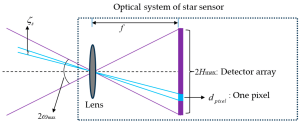A star sensor system is a critical component in modern spacecraft used for accurate attitude determination. By tracking the position of stars relative to the spacecraft, this system ensures that the satellite or spacecraft maintains precise orientation in space. This technology is vital for various missions, including communication, Earth observation, and scientific exploration, where exact positioning is essential for successful operation.

A star sensor system consists of several key components that work together to provide accurate and real-time data on spacecraft orientation:
The star sensor system operates by continuously capturing images of stars as the spacecraft moves through space. It then compares the positions of these stars with its onboard catalog to determine the spacecraft’s orientation relative to a fixed celestial coordinate system.
Once the system identifies known stars in its field of view, it calculates the spacecraft’s exact attitude. This information is sent to the attitude control system, which adjusts the spacecraft’s orientation as needed, ensuring that it stays aligned with its mission objectives.
The accuracy of a star sensor system makes it essential for a wide variety of space missions. Here are some of its primary applications:
The precision of a star sensor system is measured in arcseconds, a unit of angular measurement used in astronomy. Modern systems are capable of delivering accuracies down to fractions of an arcsecond. This high level of precision allows spacecraft to maintain stable attitudes for extended periods, which is essential for many mission-critical tasks.
Star sensors also provide stability for spacecraft during maneuvers, ensuring that any movement is smooth and controlled. This is particularly important during delicate operations like docking or while deploying scientific instruments.
Recent advancements in star sensor system technology have made these systems more compact, efficient, and accurate. Some of the notable improvements include:
The star sensor system will continue to play a crucial role in future space exploration missions. As more ambitious projects, such as manned missions to Mars or deep space exploration, come to fruition, the need for highly accurate and reliable orientation systems will grow. The development of more advanced star sensors will enable these spacecraft to navigate more effectively and perform more complex tasks in space.
Moreover, with the rise of commercial satellite constellations, the demand for compact, efficient star sensor systems is increasing. These systems ensure that hundreds or thousands of small satellites can operate in unison, providing services like global internet coverage or enhanced Earth observation capabilities.
The star sensor system offers numerous benefits for spacecraft, including:
In addition to their use in single spacecraft, star sensor systems are increasingly being deployed in satellite constellations. These constellations require precise coordination between multiple satellites to provide continuous coverage or data collection over a wide area. Star sensor systems help each satellite maintain its position and orientation, ensuring that the constellation functions as a cohesive unit.
With the growing demand for satellite constellations, the role of star sensor systems will only become more significant. These systems help satellites communicate effectively and maintain stable orbits, making them critical to the success of modern satellite networks.
The star sensor system is an indispensable tool for spacecraft, enabling precise attitude control and stable operation in space. Its applications range from Earth observation and scientific research to satellite constellations and deep space missions. With ongoing advancements in technology, star sensor systems will continue to evolve, providing even greater accuracy and efficiency for the next generation of space exploration projects.
Send us a message,we will answer your email shortly!